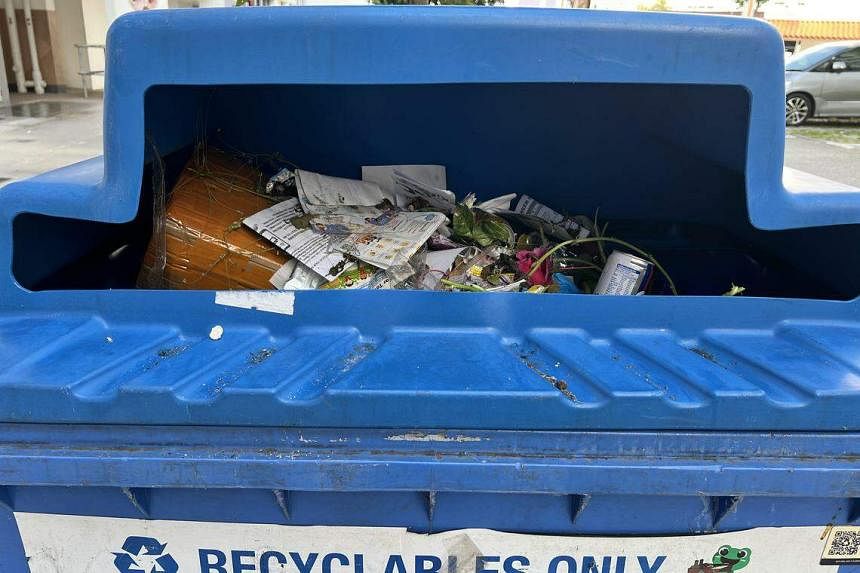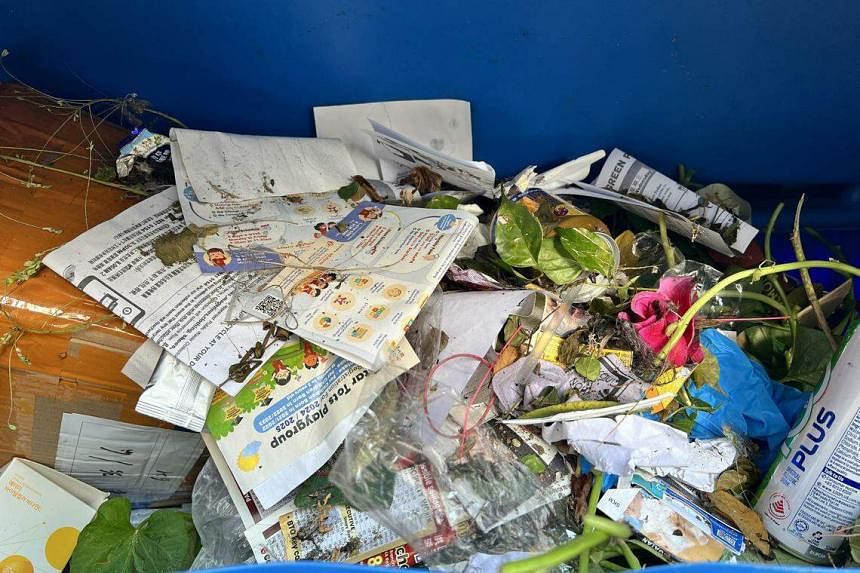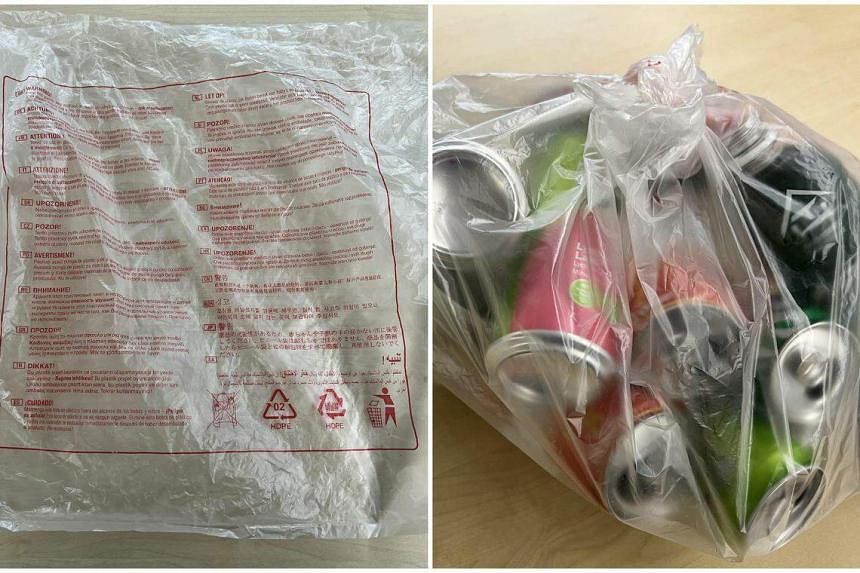askST: What is recycling contamination, and what can we do about it?

SINGAPORE – Efforts to recycle household waste in Singapore are hampered by a persistent issue: contamination.
When non-recyclables such as food and liquid waste are thrown into the blue commingled recycling bins for all paper, plastic, glass and metal recyclables, they contaminate actual recyclables, which must then be disposed of by incineration.
So, even though 72 per cent of households here recycled in 2023, the contamination rate of household recyclables in the blue bins has remained at around 40 per cent since 2017.
The Straits Times hears from environmental advocates about the contamination rate of domestic recycling in Singapore, and ways in which this can be reduced.
Q. What is considered contamination?
Contamination does not refer to just food and liquid waste coming into contact with recyclable items.

The contaminated contents of a blue recycling bin at Block 413 Choa Chu Kang Avenue 3. ST PHOTO: ARIEL YU
Other common contaminants in the blue bins include non-recyclable things like styrofoam and furniture; rubbish like tissue paper; electronic waste that should go to only e-waste collection points; and items meant for reuse, such as clothing, toys and shoes.
The National Environment Agency (NEA) said the top contaminants in 2023 were small electronic appliances (41 per cent), old clothing (41 per cent) and light bulbs (31 per cent).

Rubbish such as leaves, dirty fliers, and used tissues being thrown into the blue recycling bin. ST PHOTO: ARIEL YU
Contamination can also happen because of “wishcycling” – where items are put into the recycling bin in the hope that they are recyclable, without actually checking if they are.
It is both counterproductive and irresponsible to throw items that cannot be recycled in the blue recycling bins.
Q. Why is the contamination rate still at 40 per cent?
Singapore’s 40 per cent contamination rate is calculated by dividing the weight of items rejected by material recovery facilities by the weight of domestic recyclables collected.
One reason for this high contamination rate is that the ubiquitous blue bins are often located in open areas along roads or in Housing Board carparks, where people can blithely toss rubbish into them.
Ms Pamela Low, founder of Tingkats, a consultancy that partners businesses to take climate action, said the existing recycling infrastructure “attracts” contamination.
“There’s nothing to prevent users from throwing rubbish into recycling bins. Hence, I would suggest making the barrier to recycling higher to filter out those who do not recycle right, through the use of the tech-enabled material segregated bin,” she said, adding that this would help keep contamination out.
In spite of more investments into educational campaigns, alongside growing numbers of environmentally conscious Singaporeans, she observed contamination is still prevalent.
She added that a large cost attributed to the logistics and sorting of contamination is borne by taxpayers.
Ms Tan Huileng, executive director of the Zero Waste SG non-governmental organisation, said commingled deposits lessen the need for people to sort out their recyclables, which means they may be less mindful about keeping these items clean or cutting down on waste generation in the first place.
She said the issue of contamination is not as prevalent in the industrial sector, as recyclable waste is usually produced in cleaner and separate streams.
Another problem is that the blue bins are exposed to rain, so water can enter the opening and contaminate the recyclables, especially paper materials. NEA said commingled blue recycling bins in HDB estates are not placed at void decks for fire safety reasons.
Q. Why is it important to reduce the contamination rate of recyclables?
“The contamination of recyclables undermines the success of the entire recycling system,” said Mr Cheang Kok Chung, executive director of the Singapore Environment Council.
“Not only does it increase the processing costs, which include transporting, sorting, recycling and disposing, but it also reduces the quality of recyclables, affecting its market value.”
At a materials recovery facility, sorters manually pick out recyclables with market value on conveyor belts from contaminated recyclables, items that are not recyclable, and hazardous waste such as broken glass, used masks and diapers.
Recyclable materials are then compressed into separate bales according to material type and sold to recyclers here or overseas. Everything else is sent for incineration just like regular waste.
This means contaminated recyclables ultimately end up in the Semakau Landfill after they are incinerated, taking up valuable space.
This landfill – built for $646 million, including its second phase – is expected to be fully filled by 2035, 10 years ahead of its originally projected lifespan of 47 years.
Tingkats’ Ms Low said: “Managing waste in a land-scarce country is a huge cost borne by taxpayers.”
A low recovery rate at waste sorting facilities also has larger implications for the commercial viability of the recycling industry, to ensure its long-term sustainability.
Contamination reduces or eliminates the quality of recyclable commodities, in turn impacting the quality consistency and the supply to companies that reprocess the materials into usable feedstock for manufacturers to create new products.
A shrinking recycling industry due to something as preventable as contamination puts climate action at risk.
Ms Tan of Zero Waste SG said recyclers determine whether the price the recycled materials fetch on the market is worth the cost of obtaining and processing the waste.
Reducing contamination was a key goal in NEA’s Recycle Right campaign launched in 2019 to improve awareness on recycling.
The initiative was part of Singapore’s Zero Waste Masterplan launched the same year with the aim of reducing waste sent to the landfill.
Q. How can we do our part to reduce contamination?
Here are four ways to minimise contamination of recyclables.
1. Focus on recycling a few types of waste first
Familiarise yourself with local recycling guidelines, such as NEA’s list of recyclable and non-recyclable items, to understand what can and cannot be recycled, said Ms Koh Wei Lin, Plastic Action lead at WWF-Singapore.
It may be daunting to remember an entire list of items that are recyclable and those that are not. So start with a few recyclable items commonly used in your home, for example, plastic drink bottles, shampoo or detergent bottles, paper envelopes, tissue boxes and toilet paper rolls.
2. Clean and dry recyclables before depositing them in recycling bins
Placing recyclables with food or liquids can contaminate an entire blue recycling bin worth of recyclables.
“To prevent that from happening, Singaporeans should give their recyclables a good rinse to remove any leftover residue and, ideally, leave them to dry,” said Ms Cheryl Tan, capability development senior manager of Zero Waste SG.
3. Practise ‘defensive’ recycling
Maximise the chances of recyclables actually being recycled by minimising the risk of their contamination.
Tie up clean and dry recyclables in a plastic bag before depositing them into a recycling bin.
This helps “defend” the items until they reach a materials recovery facility, where the plastic bags are split before the items are sorted.
Ms Robin Rheaume, a zero-waste advocate, said a plastic bag can protect clean paper products from contamination and rain. “Don’t worry about using a plastic bag for this. It is removed easily at the sorting point.”
You do not have to purchase brand-new plastic bags to do so. Make use of unwanted plastic bags that are often thrown out, such as poly mailers your online purchases come in, or the plastic packaging of products like toilet paper rolls or electrical appliances.

You put your clean and dried recyclables in unwanted plastic packaging before depositing them into the blue recycling bins. ST PHOTO: ARIEL YU
4. Start a recycling corner at home
Set up a recycling corner in a convenient spot that everyone at home has access to.
This not only saves multiple trips to the recycling bin, but is also a visual cue to encourage recycling. You can use the free Bloobox NEA distributed or any large reusable container.
A pragmatic aspect of this is that your household members are – hopefully – less likely to toss food-contaminated items that risk attracting pests to your home, and any washed items have some time to dry there before you deposit them.
For more information on how to recycle right, visit https://www.cgs.gov.sg/recycleright/how-to-recycle-right
Unsure if an item can be placed in the blue recycling bins? Do a quick search on Clean and Green Singapore’s recycling search engine or Recyclopedia.sg


No comments
Share your thoughts! Tell us your name and class for a gift (: